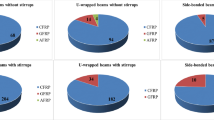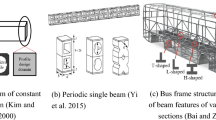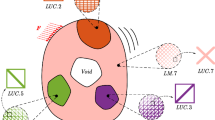Abstract
The design of RC members with nontraditional methods is demanding due to the large number of unknown variables inherent in the design process. The complexity of the RC beam design optimization problem has led to many oversimplified models, so that the current metaheuristic search algorithms can deal with it efficiently. In this paper, the optimization design model of RC beams has been introduced by new design variables, while augmented others; accordingly enhanced the solving algorithm. A new enhanced parameter-setting-free harmony search algorithm has been proposed to solve the model. Furthermore, the tackled optimization objectives were the minimization of cost, weight, and cost–weight simultaneously for designing regular or high-strength concrete beams.















Similar content being viewed by others
References
Adsul PK, Bhalchandra SA (2012) Cost optimization of doubly reinforced rectangular beam section
Akin A, Saka M (2010) Optimum detailed design of reinforced concrete continuous beams using the harmony search algorithm. 93:01. http://www.ctresources.info/ccp/paper.html?id=5838
Alqedra M, Arafa M, Mohammed I (2011) Optimum cost of prestressed and reinforced concrete beams using genetic algorithms. J Artif Intell 4:01
Babiker SA, Adam F, Mohamed AE (2012) Design optimization of reinforced concrete beams using artificial neural network, 2278–7461, 01
Beeby AW, Narayanan RS (2005) Designers’ guide to Eurocode 2: design of concrete structures. Thomas Telford Publishing. https://doi.org/10.1680/dgte2docs.31050. https://www.icevirtuallibrary.com/doi/abs/10.1680/dgte2docs.31050
Bhatt P, Macginley TJ, Choo BS (2018) Reinforced concrete: design theory and examples, 10
Bianchi L, Dorigo M, Gambardella LM, Gutjahr WJ (2009) A survey on metaheuristics for stochastic combinatorial optimization. Nat Comput 8:239–287, 06
Bittnar Z, Leps M (1999) Applying genetic algorithms to optimization of reinforced concrete beam
Birattari M, Paquete L, Stützle T (2003) Classification of metaheuristics and design of experiments for the analysis of components, 03
Calavera J (2012) Manual for detailing reinforced concrete structures to EC2. ISBN 9781482266795
Chutani S, Singh J (2017) Evaluation of enhanced particle swarm optimization techniques for design of rc structural elements. J Mater Eng Struct JMES 4(2):65–78. http://revue.ummto.dz/index.php/JMES/article/view/1498
du béton F (2008) Practitioners’ guide to finite element modelling of reinforced concrete structures: state-of-the-art report. Bulletin (fib Fédération internationale du béton). ISBN 9782883940857
EN 1992-1-1 Eurocode 2 (2005) Design of concrete structures - Part 1-1: general ruels and rules for buildings. Brussels, EN, CEN
Geem ZW (2006) Optimal cost design of water distribution networks using harmony search. Int J Model Simul 38:259–277, 04
Geem ZW (2008) Novel derivative of harmony search algorithm for discrete design variables. Appl Math Comput 199(1):223–230. https://doi.org/10.1016/j.amc.2007.09.049. ISSN 0096-3003, http://www.sciencedirect.com/science/article/pii/S0096300307009897
Geem ZW, Sim K-B (2010) Parameter-setting-free harmony search algorithm. Appl Math Comput 217:3881–3889, 12
Geem ZW, Kim J, Loganathan GV (2001) A new heuristic optimization algorithm: Harmony search. Simulation 76:60–68, 02
Geem ZW, Kim J, Loganathan GV (2002) Harmony search optimization: application to pipe network design. Simulation 22:01
Govindaraj V, Ramasamy JV (2005) Optimum detailed design of reinforced concrete continuous beams using genetic algorithms. Comput Struct 84(1):34–48. https://doi.org/10.1016/j.compstruc.2005.09.001. ISSN 0045-7949, http://www.sciencedirect.com/science/article/pii/S004579490500310X
Gulvanessian H (2001) En1991 eurocode 1: actions on structures. Proc Instit Civil Eng - Civil Eng 144(6):14–22. https://doi.org/10.1680/cien.2001.144.6.14
Harris AJ, Harrison T, Moss RM, Narayanan RS, Webster R, Bond AJ, Brooker O (2006) How to design concrete. Structures using eurocode, 2
Hasançebi O, Erdal F, Saka M (2010) Adaptive harmony search method for structural optimization. J Struct Eng ASCE 136:04
Hibbeler RC (2018) Structural analysis, 10th edn. Prentice Hall. ISBN 0134610679
Holland JH (1992) Adaptation in natural and artificial systems. MIT Press, Cambridge. ISBN 0-262-58111-6
Institution of Structural Engineers (Great Britain) and Concrete Society (2006) Standard method of detailing structural concrete =: A manual for best practice. Institution of Structural Engineers
Jahjouh M, Mohammed A, Alqedra M (2013) Artificial bee colony (ABC) algorithm in the design optimization of RC continuous beams. Struct Multidiscip Optim 47(6):963–979
Kim J, Lee HM, Yoo D (2016) Investigating the convergence characteristics of harmony search. Adv Intell Syst Comput 382:3–10, 08
Kougias I, Theodossiou N (2010) A new music-inspired harmony based optimization algorithm. Theory Appl, 01
Kulkarni AR, Bhusare V (2016) Structural optimization of reinforced concrete structures. International Journal of Engineering Research & Technology (IJERT) V5:07
Kwok T, Kong J (2006) Preliminary design of concrete structures using genetic algorithms and spreadsheets
Lee K, Geem ZW (2005) A new meta-heuristic algorithm for continuous engineering optimization Harmony search theory and practice. Comput Methods Appl Mech Eng 194:3902–3933, 09. https://pdfs.semanticscholar.org/7c4c/d2485b00e127dd540d4b75ae8af7685d80d1.pdf
Logan DL (2012) A first course in the finite element method, 5th edn. Cengage Learning. ISBN 0495668257
Mangal M, Cheng J (2018) Automated optimization of steel reinforcement in rc building frames using building information modeling and hybrid genetic algorithm. Autom Constr 90:39–57, 06
Marler TR, Arora JS (2010) The weighted sum method for multi-objective optimization: new insights. Struct Multidiscip Optim 41(6):853–862. https://doi.org/10.1007/s00158-009-0460-7. ISSN 1615-1488
Nigdeli SM, Bekdas G (2015) Optimum design of reinforced concrete beams using teaching-learning-based optimization
Olsson A, Sandberg G, Dahlblom O (2003) On latin hypercube sampling for structural reliability analysis. Struct Safety 25(1):47–68 . https://doi.org/10.1016/S0167-4730(02)00039-5. ISSN 0167-4730, http://www.sciencedirect.com/science/article/pii/S0167473002000395
Rahami H, Kaveh A, Gholipour Y (2008) Sizing, geometry and topology optimization of trusses via force method and genetic algorithm. Eng Struct 30(9):2360–2369. https://doi.org/10.1016/j.engstruct.2008.01.012. ISSN 0141-0296, http://www.sciencedirect.com/science/article/pii/S0141029608000163
Shaqfa M, Orbán Z (2018) Codes: modified parameter-setting-free harmony search (PSFHS) algorithm for optimizing the design of reinforced concrete beams. https://doi.org/10.5281/zenodo.2573261
Sörensen K (2013) Metaheuristics - the metaphor exposed. In Press, 01
Surjanovic S, Bingham D (2018) Virtual library of simulation experiments: test functions and datasets. Retrieved October 3, from http://www.sfu.ca/ssurjano
Yang X-S, Deb S (2010) Cuckoo search via levey flights. 01:210–214. https://ieeexplore.ieee.org/document/5393690. arXiv:003.1594
Yang X-S, Deb S, Fong S (2013) Metaheuristic algorithms: optimal balance of intensification and diversification. Appl Math Inf Sci 8:08
Yang X, Bekdas G, Nigdeli S (2014) Metaheuristic optimization for the design of reinforced concrete beams under flexure moments
Author information
Authors and Affiliations
Corresponding author
Ethics declarations
Conflict of interest
The authors declare that they have no conflict of interest.
Additional information
Responsible Editor: Somanath Nagendra
Publisher’s note
Springer Nature remains neutral with regard to jurisdictional claims in published maps and institutional affiliations.
Appendices
Appendix A: Flexural reinforcement
In this section, a sound direct, computationally less expensive, and a non-iterative bending capacity algorithm has been derived. The following approach, for doubly reinforced sections, replaces the conventional and iterative strain compatibility method (Beeby and Narayanan 2005; Bhatt et al. 2018) in this paper. The first attempt of this algorithm is to evaluate the neutral axis position, refer to Fig. 16, assuming that both the strains in compression and tension reinforcement yielded simultaneously, while the concrete reached its crushing strain, see (A.1) to (A.4).
After that, the tension and compression steel strains are evaluated from (A.5) and (A.6) respectively, that were derived in the first place form the triangulation of the strain distribution assumed in Fig. 16.
If the resulted strain in one of them or both, (A.5) and (A.6), is less than the yield strain it means that the acting forces on the cross section are not in equilibrium; the first assumption is violated. Attempt two is required, where the general solution is described by (A.7), and varies as described in the following cases:
-
Only the strain of the compression reinforcement yielded. In this case, the tension force, T, in steel must be modified in (A.1) to be T = AsEs𝜖s, and by solving for the neutral axis depth, the coefficients A → F of the general real positive root are depicted in (A.8) to (A.13);
$$ A = A^{\prime2}_{s} f_{yd}^{2} $$(A.8)$$ B = 2000 A^{\prime}_{s} A_{s} E_{s} f_{yd} \epsilon_{cu3} $$(A.9)$$ C = 10^{6} {A^{2}_{s}} {E^{2}_{s}} \epsilon_{cu3}^{2} $$(A.10)$$ D = 4000 \lambda \eta b d f_{cd} A_{s} E_{s} \epsilon_{cu3} $$(A.11)$$ E = -10^{3} A_{s} E_{s} \epsilon_{cu3} $$(A.12)$$ F = -A^{\prime}_{s} f_{yd} $$(A.13) -
Only the strain in tension reinforcement yielded. In this case, the compression force in steel, Cs, must be modified in (A.3) to be \(C_{s} = A^{\prime }_{s} E_{s} \epsilon ^{\prime }_{s} \) and (A.14) to (A.19) describe the coefficients to find the real positive root of (A.7);
$$ \begin{array}{@{}rcl@{}} A &=& A^{\prime2}_{s} {E_{s}^{2}} \epsilon_{cu3}^{2} \end{array} $$(A.14)$$ \begin{array}{@{}rcl@{}} B &=& -2000 A^{\prime}_{s} A_{s} E_{s} f_{yd} \epsilon_{cu3} \end{array} $$(A.15)$$ \begin{array}{@{}rcl@{}} C &=& {A^{2}_{s}} f^{2}_{yd} \end{array} $$(A.16)$$ \begin{array}{@{}rcl@{}} D &=& 4000 \lambda \eta b d^{\prime} f_{cd} A^{\prime}_{s} E_{s} \epsilon_{cu3} \end{array} $$(A.17)$$ \begin{array}{@{}rcl@{}} E &=& A_{s} f_{yd} \end{array} $$(A.18)$$ \begin{array}{@{}rcl@{}} F &=& -10^{3} A^{\prime}_{s} E_{s} \epsilon_{cu3} \end{array} $$(A.19) -
Both steel strains do not yield. This case is considered impractical and out of the scope of this paper, besides, a well-controlled design algorithm can skip such a case easily.
Note that (A.7) to (A.19) have been derived where the input units for stresses are in (MPa); hence fcd and fyd, and the moduli of elasticity are expressed in (GPa). In addition, the provided areas for both tension and compression reinforcements are in (mm2) and all the geometrical dimensions such as b, d, and d′ are in (mm). Eventually, the resulting depth of the neutral axis was declared in (mm).
Appendix B: Small-scale benchmarking
In this section, a small-scale benchmarking was used to compare the modified PSFHS with the Original Harmony Search (OHS) algorithm (Geem et al. 2001), the standard PSFHS (Geem and Sim 2010), and Cuckoo Search (CS) algorithm (Yang and Deb 2010). For this purposes, standard Schwefel function (see Surjanovic and Bingham (2018)) has been chosen with 100 design variables (dimensions).
First, both the standard PSFHS and the proposed modified PSFHS have been compared (refer to Table 17 to see the parameter settings). Figure 17 reveals a comparison between the modified PSFHS and standard PSFHS algorithms in solving the Schwefel function.
Elaborately, the modified PSFHS result for 10 independent runs was − 40, 180.400 ± 229.672, and the best achieved answer was − 40, 510.588. Note that the exact answer of the function, using 100 dimensions, is − 41, 898.290. Regarding the standard PSFHS, the overall result was − 17, 202.608 ± 1, 870.637, and the best run scored was 20,091.100.
The OHS has been tested and adjusted accordingly to solve this problem. Table 18 explains different solutions obtained with different adjustments and evaluations, where it functioned potentially better than the standard PSFHS for the same problem size.
Finally, the CS algorithm has been used to solve the same problem in this section. Fine-tuning has been implemented to obtain the best answer using different generation numbers in order to keep the number of computational efforts nearly equal and to get a sounds-fair comparison. Table 19 shows the different results obtained with different settings.
Appendix C: Miscellaneous results
In this section, the results of the fourth design case have been shown in detail. Figure 18 illustrates the ultimate and serviceability envelopes as per the Eurocodes (EN 1992-1-1 Eurocode 2 2005; Gulvanessian 2001; du béton 2008; Hibbeler 2018; Logan 2012), while Table 20 explains the results of the maximum deflection for each span taking into account the shrinkage and creep effects for long-term time spans.
1.1 C.1 Replication of results
The datasets generated during the current study are not publicly available due to the dependency of such algorithms on the time seeds used by the pseudo-random number generator to generate the results. However, we published C++ 14, Python 3.7, and Matlab codes that allow the reader to reproduce and replicate the results of the Schwefel function (refer to Appendix B). The complete manuscripts, source codes, that were generated during the current study are not publicly available; they could be subjected to commercial copyrights soon, yet they are available from the corresponding author as per reasonable request. The abovementioned codes shall be found on the online repository: https://doi.org/10.5281/zenodo.2573261 (Shaqfa and Orbán 2018).
Rights and permissions
About this article
Cite this article
Shaqfa, M., Orbán, Z. Modified parameter-setting-free harmony search (PSFHS) algorithm for optimizing the design of reinforced concrete beams. Struct Multidisc Optim 60, 999–1019 (2019). https://doi.org/10.1007/s00158-019-02252-4
Received:
Revised:
Accepted:
Published:
Issue Date:
DOI: https://doi.org/10.1007/s00158-019-02252-4







